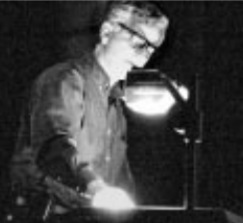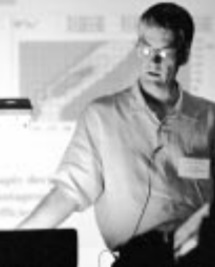Only Connect
Particle physics and astrophysics may stand at opposite ends of the universe, but research shows them inextricably linked.
Fifteen years ago, in 1984, when Fermilab held its first Inner Space-Outer Space conference, scientists were just beginning to explore the interface between particle physics and cosmology. As they tugged at the internal structure of the atom, to paraphrase explorer John Muir, they discovered that it was hitched to the other end of the universe.
"That conference was a 'coming out' party for the field," said Rocky Kolb, deputy head of the Theoretical Astrophysics Group at Fermilab.
Last month, Inner Space-Outer Space II took place, filling Fermilab's main auditorium again with nuclear, high-energy, low-temperature and cosmic-ray physicists; with cosmologists and astronomers; and with senior officials from the National Aeronautics and Space Administration, the U.S. Department of Energy, and the National Science Foundation, the federal agencies that fund the scientists’ research.
Fifteen years after the first conference, said Kolb, the interdisciplinary field of particle physics and cosmology is now "perhaps not matronly, but at least mature."
As Director Emeritus Leon Lederman put it in his book The God Particle, particle physics and astrophysics "have been fused to a new level of intimacy."
The conference was held in honor of David Schramm, an eminent cosmologist and theoretical astrophysicist who died in a plane crash two years ago. As the program for the conference noted, Schramm’s research covered many topics in theoretical astrophysics and cosmology and "was always daring and original, and often ahead of its time." Perhaps his most stunning work was a prediction from cosmology of the number of families of fundamental particles—work that was instrumental in unifying the fields of cosmology and elementary particle physics.
The four days of meetings made clear that times have changed since 1984. The COBE satellite has discovered tiny fluctuations in the microwave background radiation, evidence of irregularities in the distribution of matter left over from particle interactions in the earliest moments after the Big Bang. Sky surveys have probed even farther into the basement of time, capturing stars as distant as a redshift of 5. Inflation theory was just in its infancy in 1984, having been proposed just three years earlier; now it is the standard cosmological model.
Mysteries remain, however, and were the subject of plenary talks, parallel sessions, and breaktime discussions over pastry and coffee. No one yet knows, for instance, what dark matter is. Scientists are certain it exists: they see the distortions in the orbits of stars that only the gravitational pull of some invisible mass could explain. But the nature of dark matter remains a puzzle.
Is it made up of WIMPS (weakly interacting massive particles)? Or neutrinos? Or maybe supersymmetric particles? Bedeviled by such questions, astronomers are as eager as particle physicists for Fermilab’s Run II to begin—the next run of the Tevatron accelerator, at still higher luminosity. If the much-theorized-about supersymmetric particles are found, and their masses calculated, astronomers could determine whether they might be hefty enough to account for dark matter, or at least some part of it.
Findings in astronomy also spur research in particle physics. Recent studies of supernovae have demonstrated that the expansion of the universe is not slowing down, as everyone expected it eventually would; it is, instead, speeding up. The observations have set theorists in particle physics to work on the “missing energy,” or the cosmological constant (the “cosmo-illogical constant,” as Kolb irreverently calls it), to try to account for this acceleration.
What hasn’t changed since 1984, then, is the conviction that particle physics and astronomy are inextricably linked, and that discoveries in one advance the frontiers of the other.





